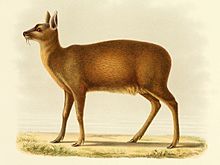Alpine musk deer
The Alpine musk deer (Moschus chrysogaster) is a deer that lives in Central Asia.[2] This species is called endangered on the IUCN Red List and it is given first-class protection by the government of China.[3]
| Alpine musk deer | |
|---|---|

| |
| Scientific classification | |
| Domain: | Eukaryota |
| Kingdom: | Animalia |
| Phylum: | Chordata |
| Class: | Mammalia |
| Order: | Artiodactyla |
| Family: | Moschidae |
| Genus: | Moschus |
| Species: | M. chrysogaster
|
| Binomial name | |
| Moschus chrysogaster | |
Appearance
changeThe fur of a musk deer is dark brown. They are 0.5 to 0.6 m high and .85 to 1 m long. They weigh 10 to 15 kg. They have long ears and short tails, and the male deer have very long canine teeth that look like tusks.[4]
Male musk deer have musk pods that can weigh 30 to 45 g.[4]
Musk deer can live 12 to 15 years.[4]
Behavior
changeAlpine musk deer all leave their feces in the same place. Scientists call this a latrine site. They do this to mark their territory, meaning to show other deer that a place belongs to them.[2][5]
Threats
changeAlpine musk deer are in danger of dying out because human beings trap them. Like other musk male deer, male Alpine musk deer have musk pods that people use musk pods to make perfumes and in traditional medicines. When people set traps for male musk deer, they trap and kill female musk deer and fawns too.[2] [5] In the 21st century, one kilogram of musk pod can pay US$45,000.[6]
The government of China keeps some Alpine musk deer in captivity.[7]
References
change- ↑ Harris, R. (2016). "Alpine Muskdeer: Moschus chrysogaster". IUCN Red List of Threatened Species. 2016. The IUCN Red List of Threatened Species: e.T13895A61977139. doi:10.2305/IUCN.UK.2016-1.RLTS.T13895A61977139.en. Retrieved July 21, 2021.
- ↑ 2.0 2.1 2.2 Paras Bikram Singh; Janak Raj Khatiwada; Pradip Saud; Zhigang Jiang (March 20, 2019). "mtDNA analysis confirms the endangered Kashmir musk deer extends its range to Nepal". Scientific Reports. 9 (1). Nature: 4895. Bibcode:2019NatSR...9.4895S. doi:10.1038/s41598-019-41167-4. PMC 6426878. PMID 30894581.
- ↑ "Rare alpine musk deer spotted in N China". CGTN. March 14, 2021. Retrieved July 21, 2021.
- ↑ 4.0 4.1 4.2 "Moschus chrysogaster". Government of Nepal: Ministry of Forests and Environment, Department of National Parks and Wildlife Conservation. Retrieved July 21, 2021.
- ↑ 5.0 5.1 Paras Bikram Singh; Pradip Saud; Douglas Cram; Kumar Mainali; Arjun Thapa; Nar Bahadur Chhetri; Laxman Prasad Poudyal; Hem Sagar Baral; Zhigang Jiang (November 24, 2018). "Ecological correlates of Himalayan musk deer Moschus leucogaster". Ecology and Evolution. 9 (1): 4–18. doi:10.1002/ece3.4435. PMC 6342099. PMID 30680091.
- ↑ "Kashmir Musk Deer Seen in Afghanistan for First Time in 60 Years". Sci-News. November 2, 2014. Retrieved July 19, 2021.
- ↑ Yewen Sun; Yujiao Sun; Zhihui Shi; Zhensheng Liu; Chang Zhao; Taofeng Lu; Hui Gao; Feng Zhu; Rui Chen; Jun Zhang; Ruliang Pan; Baoguo Li; Liwei Teng; Songtao Guo (January 21, 2020). "Gut Microbiota of Wild and Captive Alpine Musk Deer (Moschus chrysogaster)". Frontiers in Microbiology. 31: 3156. doi:10.3389/fmicb.2019.03156. PMC 6985557. PMID 32038587.
